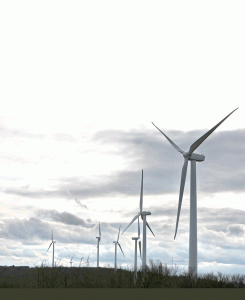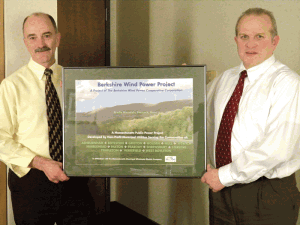
|
Triumph over Turbulence
Berkshire Wind Is Finally Ready to Make a Powerful Statement|
Posted on |
18 January 2011
|

Berkshire Winds
It’s been more than a decade in the making, and the hurdles have been high and numerous, but the project known as the Berkshire Wind Project is nearly set to start producing power. In the larger scheme of things, this is not a large power producer, but it represents a big step forward in the drive to make more of the state’s electricity green.
The winds of change will begin blowing next month when 10 turbines on top of the ridgeline at Brodie Mountain in Hancock begin turning.
Once the final electrical connections are complete, the $64.7 million Berkshire Wind Project will produce enough electricity to power 6,000 homes and will almost double the windpower generated in the state.
“Wind-turbine blades turn gracefully and work seamlessly with the environment. It is significant and important that the commercial operation of this project is just around the corner,” said David Tuohey, director of communications and external affairs for Massachusetts Municipal Wholesale Electric Co. MMWEC, as it’s called, and 14 nonprofit, Massachusetts municipal utilities are members of the Berkshire Wind Power Cooperative Corp., which owns the project.
Ronald DeCurzio agreed. “We are proud of the commitment that the municipal light departments made to this project and are glad it is finally coming to fruition,” said MMWEC’s chief executive officer, who is also chief financial officer and secretary for the Berkshire Wind Power Cooperative Corp. (BWPCC).
The electricity it generates, which the participating utilities will share, stands as a real testament to the tenacity and belief in green energy on the part of everyone involved. The project has taken 12 years to complete, was held up for a year due to legal constraints, and cost almost $10 million more than anticipated.
|

David Tuohey, left, and Ronald DeCurzio say the 10-turbine, 15-megawatt Berkshire Wind project, which is the largest in the state, is expected to be operational next month.
In fact, although recent construction work has gone smoothly, the negotiations and financing were so difficult that the original project developer sold the property and BWPCC experienced sweeping setbacks that generated a tremendous amount of frustration.
“There is no such thing as a simple wind project,” said DeCurzio. “But we are finally here, and the project will meet all of our objectives.”
Climate Change
The story began in 1998 when the property at the top of Brodie Mountain attracted wind-project developer Distributed Generation Systems Inc. (DGS) of Colorado. Tuohey explained that the ridgeline was highly desirable because it is the premiere inland wind site in the state. It earned a Class 6 wind rating from the American Wind Energy Assoc., which rates the wind-generating potential of properties on a scale of 1 to 7.
“The wind speeds there are not only high, but they are consistent,” he said.
Over time, DGS obtained most of the required permits as well as easements from property owners along the road that led to the property. “They did some preliminary work on the site and some preliminary construction work,” Tuohey said. “But they had to make many changes in project design to get to that point. There were permitting issues with the town and challenges to those permits.”
Still, the project held promise, and in 2004 MMWEC signed a contract to purchase the energy it would generate. But three years later, there hadn’t been much more progress, and the agency had the opportunity to buy the property.
“The developer had essentially reached the end of his rope,” Tuohey said, citing endless legal battles and delays as the reason for the sale.
In order to obtain financing, MMWEC and its 14 utility companies formed the Berkshire Wind Power Cooperative Corp. “In 2008, we purchased the property for $4 million. There was a high level of interest in developing renewable energy on the part of our members,” Tuohey said, adding that the project was completely sold out and the agency turned away other municipal light departments who wanted to be part of it.
In September 2008, state officials praised the project at a conference held in the Berkshires. “They were pleased because the Commonwealth has a goal of putting 2,000 megawatts of wind energy into place by 2020,” Tuohey said.
Gust in Time
The timing also proved serendipitous. Peoples-Bank of Holyoke, which was developing a customer base for green projects, gave the new cooperative an $8 million loan. And due to the downturn in the economy, manufacturers were eager to sell wind turbines they were stuck with after projects on various drawing boards were stalled or abandoned due to the troubled economy.
“They offered us a great deal for 10 turbines, but we had to come up with $21 million within three months, which is why we formed the cooperative,” DeCurzio said.
BWPCC put a deposit on the turbines and took a $52.5 million short-term loan in July 2009 to finance the rest of the project. Construction began in June, but by October operations were suspended due to litigation over a permit for the project’s access road, which resulted in a court injunction forbidding use of the road to complete construction.
“The town of Lanesboro [where the road is located] was completely behind the project. But Silver Leaf Inc., a Texas time-share developer which had purchased the adjacent Brodie Mountain Ski Area, challenged our right to use the road,” DeCurzio said, adding that the Massachusetts Land Court in Boston issued the injunction that prevented their vehicles from traveling on it.
Three turbines had been erected, but the rest were sitting nearby in New York and had to be put in storage. In addition, the site had to be demobilized, which included taking down an enormous crane that required 20 flatbed trucks to remove.
“It was a very frustrating time,” DeCurzio said. Construction was suspended for a year, and the cost of the project rose by nearly $10 million due to the delay, which increased construction costs and added legal fees and other expenses.
However, the legal battles were resolved last fall, and construction commenced in October. Within months, all of the turbines had been put in place. “It was a very efficient process once we were able to get going,” Tuohey said.
But DeCurzio says the delay may prove detrimental to future projects.
“It was a drawn-out process that took a year longer than it should have, and unfortunately left a bad taste in the mouths of our municipal light departments who really had had an interest in the project,” he said. “I think some companies may hesitate with future wind-turbine projects because of the difficulties that went on with this project.”
Both he and Tuohey also decry the lack of federal incentives for renewable-energy projects available to nonprofit utilities. Although they are exempt from the Massachusetts renewable portfolio standard, which requires private utility companies to invest in renewable energy, they feel that incentives should be comparable for public power.
“If this project was owned by a private utility or developer, we would have been eligible for a grant that would have covered 30% of the cost,” Tuohey said, explaining that grant money would have enhanced project benefits for consumers.
Higher Ground
DeCurzio says he’s proud of everyone who held strong throughout the storms that beset the initiative.
He told BusinessWest that, despite all of the setbacks, the Berkshire Wind Power Project was undertaken for the right reasons, and everyone is excited for the turbines to begin turning.
“Given the delays and added costs, the commitment of these utilities to green energy has been extraordinary. This was very proactive. Even though these utilities were not required to do this, they wanted to do their part to work toward the future in reducing their carbon footprint,” he explained.
The green project has many benefits, which include enhancing the cooperative’s company energy portfolios. In December 2010 the cooperative issued close to $65 million in tax-exempt revenue bonds for which they received ‘A’ credit-level ratings. Proceeds will be used to repay the $52.5 million short-term loan, with the remainder used for additional construction costs and other necessary measures, including a reserve fund.
“This is not the cheapest game in town,” DeCurzio said. “But it represents a key part of the future of Massachusetts.”
In addition to generating electricity, green-energy projects create jobs. “Renewable-energy projects are a primary source of new jobs, so all the benefits of this project are not really accounted for in its price,” Tuohey said. “It will help reduce dependence on fossil fuels, and “there are also a number of social, environmental, and economic factors that need to be considered. You don’t see the benefit now in dollars and cents, but eventually you will.”
Since the investment makes up only a small percentage of the energy portfolios of the 14 utilities who took part in the project, it won’t result in a rate reduction or have an adverse financial effect on them. And within a month, their customers in Ashburnham, Boylston, Groton, Holden, Hull, Ipswich, Marblehead, Paxton, Peabody, Shrewsbury, Sterling, Templeton, Wakefield, and West Boylston can smile when the wind gusts, knowing it is helping to generate part of their power.
“This is a relatively small project, but every bit of green energy helps,” Tuohey said.
Both officials also credit the towns who supported the project. “The communities were excited about this,” DeCurzio said. “There was none of the ‘not in my backyard.’ We can see the turbines getting ready to spin, and, finally, we are here.”
At the top of the mountain, showing what can happen when companies commit to using natural energy to propel them into the future.|






